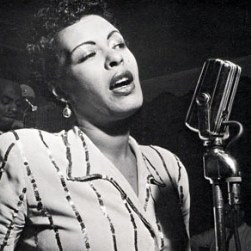Billie Holiday, Vocal jazz Artist

Eleanora Fagan professionally known as Billie Holiday (April 7, 1915 – July 17, 1959),
Billie Holiday was a jazz singer with a career spanning nearly thirty years. She was nicknamed “Lady Day” by her friend and music partner Lester Young; she had a seminal influence on jazz music and pop singing. Her vocal style, strongly inspired by jazz instrumentalists, pioneered a new way of manipulating phrasing and tempo. She was known for her vocal delivery and improvisational skills.
She was a successful concert performer throughout the 1950s with two further sold-out shows at Carnegie Hall. Due to personal struggles and an altered voice, her final recordings were met with mixed reaction, but were mild commercial successes. Her final album, Lady in Satin, was released in 1958. Holiday died of cirrhosis on July 17, 1959.
Born: Philadelphia, Pennsylvania, USA
Genre: Jazz, Swing
As a young teenager, Holiday started singing in nightclubs in Harlem. She took her professional pseudonym from Billie Dove, an actress she admired, and the musician Clarence Holiday, her probable father. At the outset of her career, she spelled her last name “Halliday”, her father’s birth surname, but eventually changed it to “Holiday”, his performing name.
The young singer teamed up with a neighbor, tenor saxophone player Kenneth Hollan. They were a team from 1929 to 1931, performing at clubs such as the Grey Dawn, Pod’s and Jerry’s on 133rd Street, and the Brooklyn Elks’ Club. Benny Goodman recalled hearing Holiday in 1931 at the Bright Spot. As her reputation grew, she played in many clubs, including Mexico’s and the Alhambra Bar and Grill, where she met Charles Linton, a vocalist who later worked with Chick Webb. It was also during this period that she connected with her father, who was playing in Fletcher Henderson’s band.
Late in 1932, 17-year-old Holiday replaced the singer Monette Moore at Covan’s, a club on West 132nd Street. Producer John Hammond, who loved Moore’s singing and had come to hear her, first heard Holiday there in early 1933.
Hammond arranged for Holiday to make her recording debut, at age 18, in November 1933, with Benny Goodman. She recorded two songs: “Your Mother’s Son-in-Law” and “Riffin’ the Scotch”, the latter being her first hit. “Son-in-Law” sold 300 copies, but “Riffin’ the Scotch”, released on November 11, sold 5,000 copies. Hammond was impressed by Holiday’s singing style and said of her, “Her singing almost changed my music tastes and my musical life, because she was the first girl singer I’d come across, who actually sang like an improvising jazz genius.” Hammond compared Holiday favorably to Armstrong and said she had a good sense of lyric content at her young age.
She was a successful concert performer throughout the 1950s with two further sold-out shows at Carnegie Hall. Due to personal struggles and an altered voice, her final recordings were met with mixed reaction, but were mild commercial successes. Her final album, Lady in Satin, was released in 1958. Holiday died of cirrhosis on July 17, 1959.
She won four Grammy Awards, all of them posthumously, for Best Historical Album. She was inducted into the Grammy Hall of Fame in 1973. Lady Sings the Blues, a film about her life, starring Diana Ross, was released in 1972. She is the primary character in the play (later made into a film) Lady Day at Emerson’s Bar and Grill; the role was originated by Reenie Upchurch in 1986, and was played by Audra McDonald on Broadway and in the film. In 2017 Holiday was inducted into the National Rhythm & Blues Hall of Fame.
Biographical information courtesy of Wiki; for more reading see link below.
https://en.wikipedia.org/wiki/Billie_Holiday
